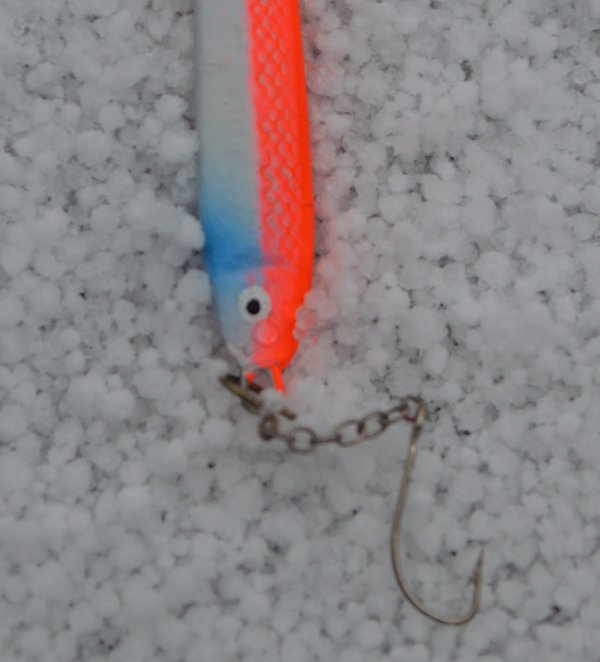Articles
By Chris Engle, contributor
There was one day a year at the convenience store where I worked in college when every item in the shop – from the dustiest Caramello candy bar to the freshest pack of Camel cigarettes – was counted and logged.
January 1 was Inventory Day and I managed to weasel out of it every year, leaving the tedium to my coworkers at the cost of time-and-a-half wage of $7.75 an hour.
In theory, the idea was to start every year off fresh with a list of what we had in stock. In practice, it was an excuse to get rid of anything past its expiration date which, let’s be honest, included every single Caramello.
Though I never participated in Inventory Day I have personally applied the concept to my collection of fishing tackle ahead of every season.
With ice fishing so delayed this year I thought I’d take the time to share with you what my inventory holds. In return, I’d like to hear your suggestions on must-have lures for a winter tackle box.
I’ve ordered my list by species and have included photos for reference because I honestly can’t remember what most of these lures are called.
Panfish
In summer, bluegills, sunfish and crappie are aggressive feeders, gobbling down big chunks of worm and minnows casted on jigs. In winter their metabolism, appetite and physical activity slows to a crawl and bait presentations need to be adjusted accordingly.
By watching on an underwater camera and through the hole in a dark shanty, I’ve seen that panfish feed by approaching the bait slowly and slurping it in horizontally. The best option is to use a horizontal jig with a #8 or smaller hook bending upward.
My choice for panfish: #8 tungsten jig, the pinker the better.
Some of these jigs have flat bodies which help impart a nice wiggling action to a bait when jigged lightly. The tungsten ones are also heavy for their size which lets you go without a split shot, meaning less distraction for bluegill. My favorite colors: hot pink/yellow.
Perch
I’ve always preferred using minnows for perch and any lure that lets the minnow swim freely will work to your benefit.
This style of teardrop has been my go-to for perch for years. Bobber for size comparison.
Weighted tear drops that hang vertically will allow a back-hooked minnow to move in a circular motion and attract more fish. Some anglers will hook a minnow further back on the tail and make the baitfish swim faster in order to right itself. Favorite colors: white, green, pink.
Walleye
Most tipup fishermen will use a super sized perch rig for walleye and bait those lines with walleye minnows (blues or grays).
I don’t have much luck with tipups and prefer to be more hands-on with my tactics. Thankfully there’s some great jigs for this purpose.
Looking like miniature stingrays, these winged jigs fly and glide in wide circles when jigged and are good at kicking up sand and silt from the bottom as a way to attract fish. At rest, a large lip-hooked minnow can still swim freely on the horizontal hook.
My walleye jigs of choice.
It’s important to remember to keep your line taut on the down-stroke because that’s when most walleye hit. A slack line means you won’t feel the bite and you’ll probably miss the fish. Favorite colors: Yellow, orange, green.
Trout
The most predictable thing about rainbows and splake is that they are unpredictable. Any of these tactics applied on trout lakes will catch fish but I’ve always found spoons to be the best bet.
Trout are in deeper water and this calls for a heavy lure that’s going to sink fast. The gold standard for ice-fishing spoons is the Swedish Pimple, a slim, dense lure that falls straight down where you want it.
Swedish Pimples come in all sizes and several different shapes but I’ve always preferred the smaller, narrowest versions. New lures come with an extra single hook and red or yellow plastic accents. I usually opt for the treble hook (to bait up with two waxworms or minnows) and the red plastic fin to mimic blood.
Mepps spoon on left, Swedish Pimple on right.
If you’re looking for more action in your lure, consider a Mepps Little Wolf. Its curved spoon shape will spin and flutter more with each jig but be careful: You’re more apt to get tangled and twisted with one of these. Favorite colors: silver, blue, pink, gold.
Smelt
The lakes around Otsego County where trout reside often have smelt too, but it’s going to take a much more subdued tactic to catch these finicky fish.

Again you’ll be in deep water so you will need a heavy lure that can get back down to the fish quick. You’ll also need a small hook for the smelt’s tiny mouth.
For smelt it’s all about the Hali Jig, a pencil-shaped spoon with a thin, wiry hook dangling from a fine chain. Favorite colors: silver, blue, pink, white.
In the past couple years I’ve doubled my odds at a fish by tying a small black nymph fly about 18 inches to 2 feet above my Hali jig and tipping it with a waxworm. I catch about half of my fish on the Hali; the other half, on the fly.
Just a warning: If you have a fish on the Hali Jig, be careful as you bring it up to the hole. The fly has a tendency to snag on the bottom edge of the ice and I’ve lost a few fish when this happens.
The last item for the inventory is ice. Let’s hope it shows up soon!
Chris Engle is an avid outdoorsman and outdoor columnist for the Gaylord Area Convention & Tourism Bureau and the Gaylord Herald Times. He lives in Hayes Township, Otsego County. He can be reached at englemobile@gmail.com.

